Paint for painting radiators must withstand high temperatures, i.e. be heat resistant. It is also good if it meets the requirements of environmental friendliness, i.e. does not emit harmful and unpleasantly smelling substances when heated.
Paint role:
- Making it aesthetically pleasing
- Corrosion protection
- Protection against aggressive environmental influences
How to remove old paint from a radiator
Before applying new paint, the surface must be prepared. To begin with, coarse dust is removed with a vacuum cleaner, fine dust can be wiped with a damp cloth. Grease stains are easily amenable to solvents and dishwashing detergents.
If the old coating is well preserved, does not flake off, does not swell, rust spots do not appear through it, then for simplicity and to save time, you can simply go over it with sandpaper so that the new layer of paint adheres well to the old one.
If the old paint has a completely unpresentable appearance, then you will have to get rid of it.
You can remove the coating from the battery as follows:
- Drill with a nozzle in the form of a hard brush - ruff
- Solvents - flushes
- Sandpaper.
Mechanical means of removing the old coating guarantee a large amount of dust, and if used carelessly, they can damage the battery itself.

Nozzles for removing paint
In this regard, chemicals are safer, but you should work with them in a ventilated area and use protective equipment - gloves, a respirator, goggles, etc. Also, do not smoke or make fire, because solvents are flammable.
As a rule, solvents are available in the form of a thick liquid or gel. They are applied in an even and not too thin layer evenly over the entire surface of the battery. For application, metal or wooden spatulas or brushes with natural bristles are used. Spatulas made of rubber or plastic will simply dissolve from aggressive chemical exposure.
The gel is kept on the surface for the time specified in the instructions, after which it is cleaned off with the same spatula along with pieces of softened paint. Solvent residues are washed off with water.
Rust can also be removed by mechanical sanding or corrosion inhibitors. Large dents or chips should be sealed with putty.
After that, dust and dirt from old paint should be removed, allow the battery to dry. Next, a primer suitable for the given type of radiator metal and the selected paint is applied. It contains small sandy particles, the role of which is to increase the adhesion (adhesion) of the surface with the paint.
There are also paints that already contain substances similar to the primer, which perfectly protect the battery metal from corrosion and adhere well to the surface.
Coloring process
It is better to paint batteries outside the heating season, then the paint will dry evenly, there will be no smudges, cracks, swelling, etc. If this is not possible, then the thinnest possible layer should be applied. Ideally, if the battery is not yet installed, or it is possible to remove it to paint over everywhere.
Important ! All colors on water based must be applied over a primer. When applied directly to the metal of the battery, you will have to deal with the rapid appearance of rust through the paint.
To keep the floor clean, use unnecessary cloth or newspapers under the radiator. If the dye is applied from a spray can, you will also have to cover the adjacent surface of the walls with something.

Battery painting with a brush
For work, it is better to choose brushes with soft bristles, less splashes will scatter from them. An ordinary old toothbrush will help you get to the most inaccessible places. In order not to get dirty on an already painted surface, it is better to first paint over the internal parts of the radiator. Paint should be applied from the top of the radiator down.
Do not try to immediately evenly paint the battery in one layer, it is still unlikely to succeed. Two neat thin layers will be better, because one thick one will dry much longer, it may leak. The time for which the dye layer is completely dry is usually indicated on the packaging. It is not worth applying the second layer ahead of time, the coating will turn out to be uneven, sloppy.
Coloring can be done not only manually, but also with a spray gun or from a spray can.

Paint for batteries in a can
Paint selection
Although conventional paints intended for walls, floors and ceilings are used for heating batteries, this is not the best solution. They are not designed for temperature effects, and therefore they will crack much faster and acquire a yellowish tint.

Heat resistant paint for radiators
When choosing between matte and glossy paints, it should be borne in mind that a shiny coating will strongly attract the eye and emphasize all the imperfections and surface irregularities. A light matte finish will turn gray over time, because dirt will accumulate in the porous structure of the paint.
Although the usual color of the batteries is still white, this is more of a tribute to the Soviet past, when the choice of colors was not rich. In fact, white radiators will only look good in light-colored interiors. For bright or dark rooms, you should choose a different color for painting.
Interesting ! The battery can be turned into a noticeable and eye-catching detail of the interior if you paint it in bright colors, draw patterns or whole pictures.
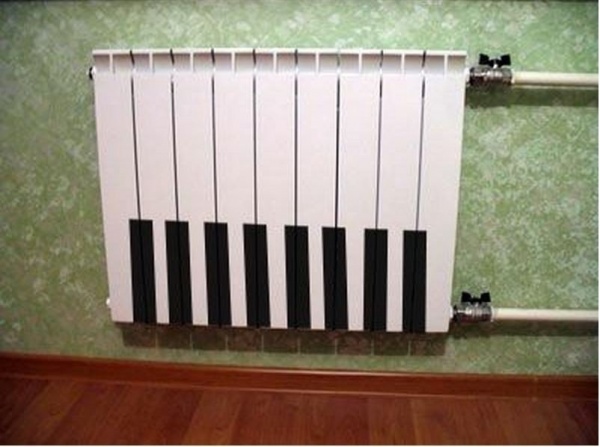
Painting aluminum radiators
Aluminum batteries themselves have a neat looking and even finish and do not need additional painting. If the convection plates of the radiator are located very often, then their coloring will significantly reduce the heat transfer of the device.

If their appearance hurts the eye, then it is better to close them with a screen or make them furniture. If these options are not suitable for some reason, then the radiators can, of course, be painted. But paints suitable for cast-iron batteries will not adhere well to an aluminum surface. Such radiators should only be spray-painted. Moreover, this should be done during the heating season, because on cold batteries at room temperature the paint will dry for a very long time.

Important ! It should be noted that most manufacturers of aluminum radiators consider their unauthorized painting as a sufficient reason to terminate the warranty service.
Types of paints
Alkyd
Alkyd paint for a heating battery is organic, silicon-organic or water-based. In the first few hours after application, it has a strong smell, which then disappears completely. With the beginning of the heating season and the heating of appliances, the smell may return for a short time.
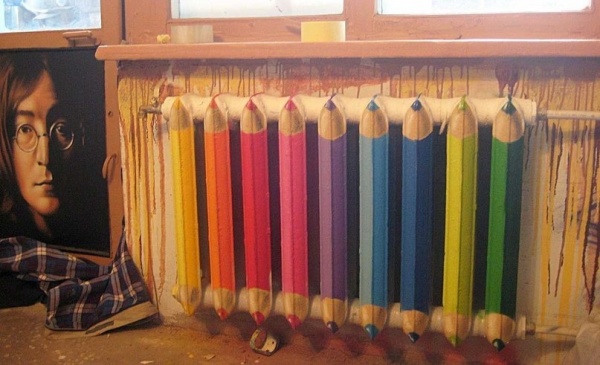
If white paint is chosen, then it is best to purchase one that contains titanium pigment. Options with a chalk content, although they will cost significantly less, will quickly turn yellow during operation.
Acrylic
Acrylic paints for radiators look and feel strongly reminiscent of plastic. This cover stays on well and is easy to clean. If the acrylic dye has a water base, it will be completely devoid of an unpleasant odor.
Hammer
Hammer enamels allow you to get shades of the same color and different textures. A non-uniform coating will perfectly hide irregularities and other surface imperfections.
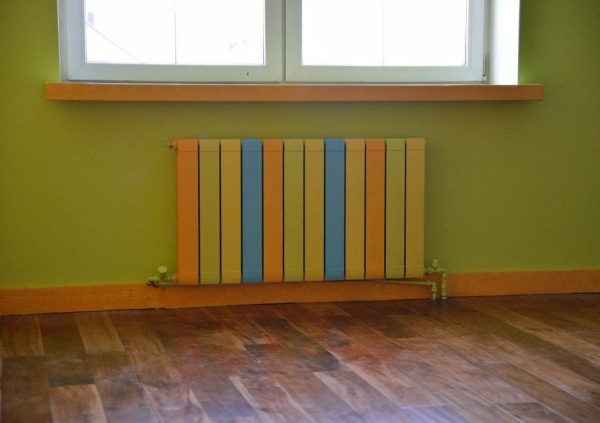
Preparation for application and the coloring itself will not differ from the usual. The only thing that is required is to sand the radiator to create a rough surface.
Water emulsion
Many people wonder if it is possible to paint batteries water-based paint. Of course, you can, because. it combines resistance to high temperatures, fast drying and the absence of an unpleasant odor. However, it is significantly inferior in durability to other species.
Powder
Gaining popularity so-called. powder coating. The dry mixture is applied from a special gun due to a small difference in electrical potentials between the radiator and the powder itself. After application, such paint must be polymerized. Indoors, this can be done with a heat gun, and if the radiator is removed from the wall, it can be placed in the oven. There are also options for powder dye that hardens when exposed to ultraviolet light. However, ordinary sunlight is not enough for this, it is necessary to use an ultraviolet lamp.
silicate
Paint for batteries based on silicate resins and aluminum is designed to work even with very high temperatures, which in practice do not happen in a heating system. After solidification, the material forms a dense, durable, but plastic layer, due to which no cracks will occur during thermal expansion and contraction of the metal. Such paint does not require preliminary application of a primer and has very high adhesion to the surface. Among the disadvantages of this option are only a high price and a strong odor that takes a long time to fade.
Serebryanka
It has long been used for painting radiators and silver - a mixture of varnish with aluminum powder. Such paint perfectly withstands high temperatures. It should be applied either over the layer of the old coating or on the base in the form of a primer. Since silverware contains oil products among the components of the varnish, it has a fairly persistent strong odor, i.e. the room must be thoroughly ventilated.

Advice ! Car enamels in spray cans are very well suited for painting heaters, because. they are also designed for strong heating during operation and application to metal surfaces.
Conclusion
What paint to paint the radiators is ultimately up to the buyer. It is only necessary to carefully weigh all the advantages and disadvantages of each of the possible options. For a room where this moment people live better fit quick dry paint for odorless heating batteries.
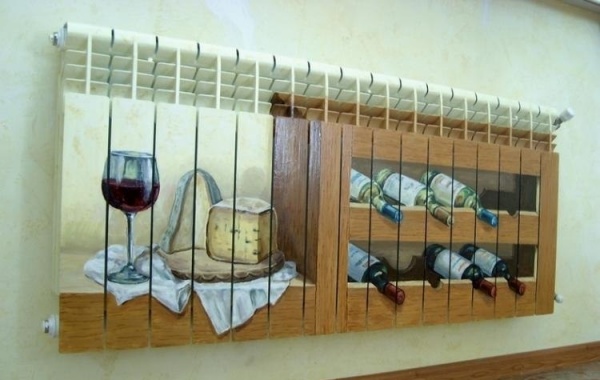
In a not yet residential area, paints that dry for a long time, but have a longer life of further paint service, are also suitable. You should not save on the material, it is better to give preference to proven and famous brands. To check how much in reality the performance of a particular paint corresponds to the declared ones, and decide which battery paint is better, user reviews, which can be easily found on the Internet, will help.
One-component heat-resistant enamel for anti-corrosion protection of steel (including carbon, stainless and galvanized) and for painting metals from aluminum, magnesium, titanium alloys operating at temperatures from -60°C to +210°C. It is a solution of acrylic, epoxy and formaldehyde resins with the introduction of an acidic diluent. BUTanti-corrosion heat-resistant enamel for ferrous and non-ferrous metals.
Heat resistance up to +125°С
. increased adhesion to metals
. weather resistance and moisture resistance
. oil and petrol resistance
Thermacryll paint combines a rust converter, anti-corrosion primer and wear-resistant enamel. Thermal paint can be used on tightly adhering rust with a thickness of corrosion products up to 40 microns, as well as on fiberglass and ceramics.
Application
heat resistant paint Thermacryllused for corrosion protection of metal structures, heating appliances and equipment, painting metal pipes for heating, steel radiators and cast iron radiators, steel products, galvanized steel, aluminum and its alloys, for protective coating of wires, cables operated at temperatures from -60 °C up to +210°C, as well as for marking.
Heat-resistant enamel is used to protect products operating in an aggressive industrial atmosphere, thermal enamel has increased weather resistance, moisture resistance, oil and petrol resistance (oil and petrol resistant paint).
Mode of application
The metal surface must be dry, free from dirt, dust, oils. In the presence of loose seam rust, clean the surface manually or mechanically to a degree of at least St 2 according to MSISO 8501.
Before applying the enamel, mix until smooth.
To working viscosity, dilute with a solvent (5-10%): R-646, R-648, R-4, R-5, R-6.
Working viscosity when applied by pneumatic spraying, brush, roller 18-25 s.;
Application temperature: from -15°С to +40°С and relative air humidity not higher than 80%. After the layer has dried for 1 hour at +20°C, the next layer can be applied.
Drying time to degree 3: at +20°C - 30-60 minutes, at +60°C - 10-15 minutes.
Heat resistance: at +160°C permanently, at +210°C for at least 5 hours.
Consumption
Enamel consumption is 100-150 g/sq.m., with a single layer thickness of 30-35 microns. 2 coats recommended.
Precautionary measures
Do not work near open sources of fire! When working, it is necessary to use personal protective equipment, with constantly working supply and exhaust ventilation.
Color
All RAL colors
Tara
Euro bucket 20 kg.
Storage
Keep away from fire. Store the composition in a tightly closed container, protected from heat, direct sunlight and moisture at a temperature of -30 to +30°C. Guaranteed shelf life in the original packaging is 8 months from the date of manufacture.
Technical details
Paint for heating radiators is simply necessary, as it performs the function of a protective coating. It prevents the appearance of corrosion and damage during the operation of the heating element for a long time. To extend the life of the radiator, you need to use only high-quality enamel.
As a standard, paint for radiators should be odorless, non-toxic and more or less resistant to mechanical damage and thermal shock. The chemical industry represents a huge range of products that belong to this niche, but it is important to make the right choice in accordance with all characteristics. So which paint is best?
Types of paints
It is wrong to think that a radiator for heating can be coated with any paint with a high quality index or a significant cost. So, in the past, oil or aluminum paint was often used for heating radiators. Considering them to be the best option for this device, the use was ubiquitous.
Painting radiators using such substances is unacceptable under these conditions, since their function does not imply protection of the metal surface during high temperatures Oh. Thus, the paint on the radiators quickly fades, cracks and even peels off, requiring re-treatment.
Imperfect versions were replaced by paints more suitable for thermal elements. The most optimal options are the following types of enamel:
- Alkyd. This composition can be used at temperatures not exceeding 150 degrees. When the temperature rises, the color gamut does not change in any way. The paint has an unpleasant smell, which disappears after one week after staining. The cost is quite high.
- Acrylic paint for radiators. This is an odorless paint that can withstand approximately 80 degrees. Only white paint is on sale, in which a dye is added. Affordable price and availability of goods often bring it to the first place.
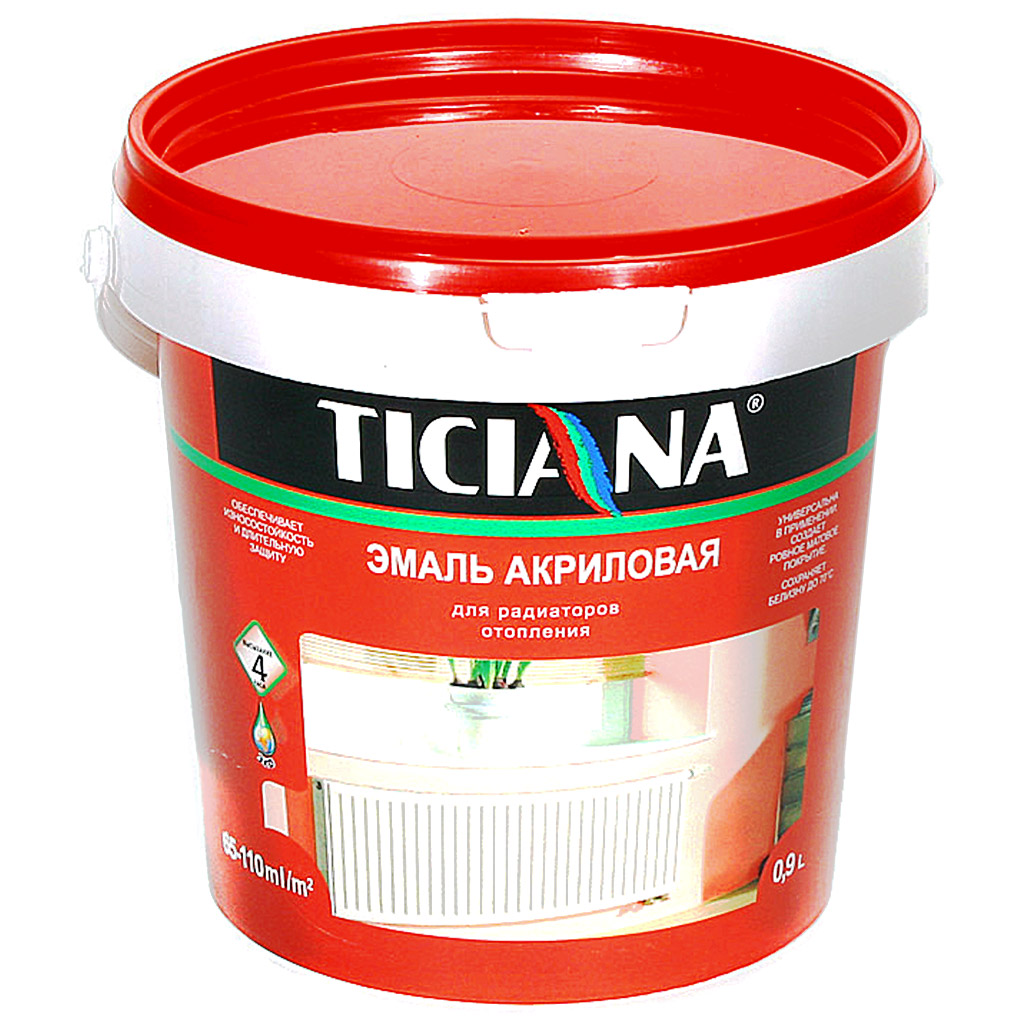
- Silicone aluminum. Long-term use can be up to five years without re-coating. The range of temperature conditions reaches 500 degrees. The elasticity and adaptability of the composition to thermal expansion and contraction make the enamel practically invulnerable. The cost of such a substance is quite high, while there is an unpleasant odor that is retained for a long time. Such analogues dry quickly.

- Aluminum with heat-resistant varnish. In the people, such paint is called silver. Used at a maximum temperature of 200 degrees. It should be applied only to a prepared heater and it is advisable to use it in non-residential premises. The composition contains many variations of petroleum products, which makes the enamel non-environmental. Smells bad and lasts a long time. Cost is moderate, availability is wide.

The advantage of such paint coatings in comparison with standard options is obvious. Odorless paint for heating radiators cannot be completely, but there are other positive characteristics.
The above compounds are resistant to thermal effects, wear-resistant during operation and do not have a persistent unpleasant odor.

What paint is better to choose
The aesthetic appearance of the radiator will largely depend not only on the cost of the selected paint, but also on compatibility with the material of the radiator itself, as well as the features of its design. What paint to paint? For primary staining, it is better to use glossy options. Paint for painting re-type heating batteries is used exactly matte - its base will hide all the irregularities and shortcomings of the radiator.
Consider examples of painting different types of radiators in accordance with their features:
- Paint for cast iron heating radiators has many nuances when painting, which relate to irregularities and not quite aesthetic joints, seams. In most cases, even matte paint does not hide all the nuances. The only right decision would be to use colored paint that repeats the shade of the interior design of the walls. If there is a need to color the battery in bright hues, then the base of the device is pre-putty.
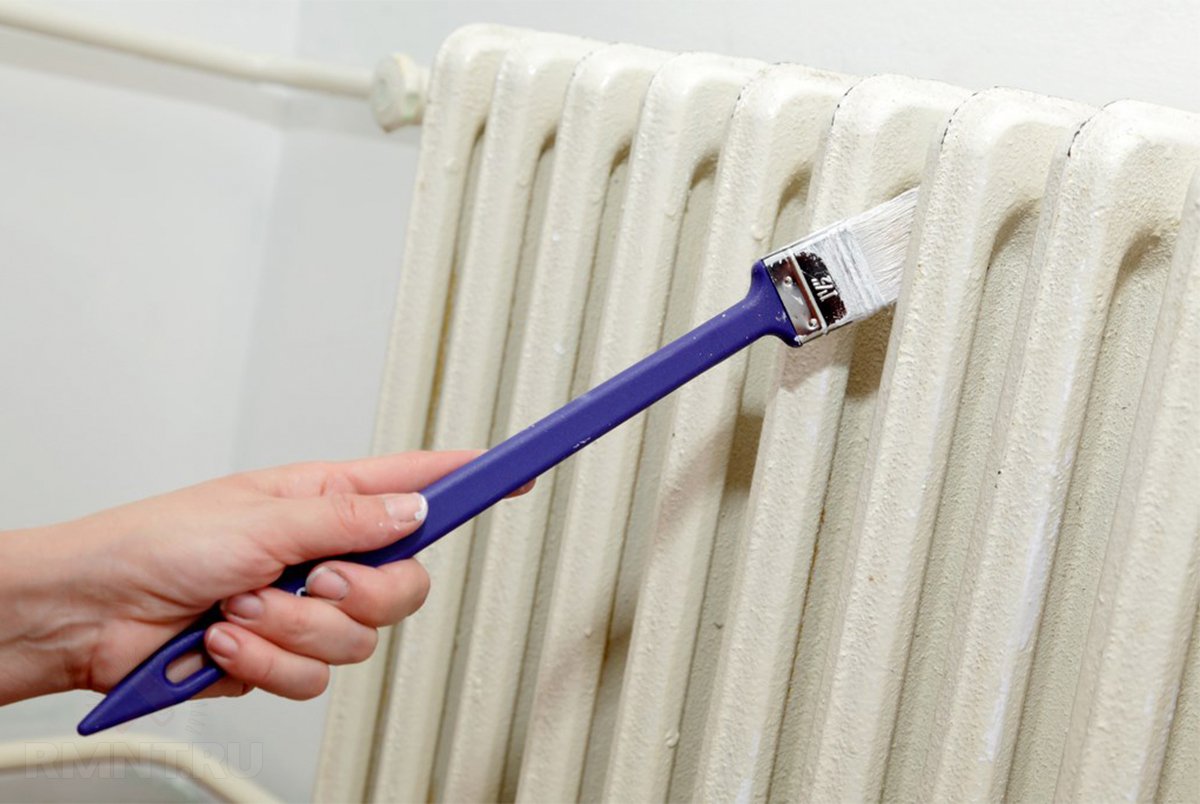
- Aluminum and bimetallic radiators are best painted with powder paints, but not white. The downside is that it is almost impossible to process at home. First, you need special tools. Secondly, in order to perform high-quality staining, special skills are needed.

- Spray paints, that is, paints in cans, are the most popular at the present stage. This feature is inherent in the fact that the method of applying the agent to the surface is the simplest. The main thing is to cover the wall with some material so that it does not get dirty. It is often necessary to apply at least two coats to level the surface. It is a quick dry option.

It is better when choosing a paint to seek help from a specialist. The seller will be able to suggest which paint is best correlated with a particular type of radiator. It is necessary to take into account the preferences that relate to interior design.
Often, with the help of several types of paints, it is possible to create a visual combination regarding tone or color. It does not make sense to single out any one section of the battery.

On the video: how to quickly transform an old battery.
Preparatory work
After the choice of paint for the radiator is made in accordance with the requirements for the composition and functional features of the product, you can proceed to the preparatory stage. It consists of the following actions:
1. First, it is worth treating the surface of the radiator. Usually secondary painting is carried out, so it is important to accurately assess the condition of the radiator before processing. If at least five layers of paint have already been applied to the battery, then it is better to remove the excess with the help of mechanized cleaning.
2. In case of severe damage to the previously applied layers, if the paint is cracked or peeling, it must be completely removed to the very base of the metal. For this, special machines or chemical flushing agents are used. This procedure should be carried out especially well.
3. In the case when there are no more than three layers, it is enough to treat the surface with sandpaper. It is worth choosing the fine-grained one. All streaks and drops that have formed as a result of preliminary staining are preliminarily cut off. It is necessary that the surface is smooth, without the slightest roughness.
4. After processing with sandpaper, processing is carried out with chemicals that degrease the surface. This can be done with acetone or a solvent. Often such work requires several degrees of processing. Only after that enamel is applied to the surface.

Staining steps
So that the result does not disappoint, and the money is not thrown to the wind, it is better to paint the radiator in accordance with a certain technology:
1. Prepare workplace: cover the floor and close the wall. To pick up tools for painting. Only brushes are suitable, sponges are sometimes used. The roller in this type of work is definitely not suitable. The worker must cover his hands with gloves.
2. Paint on a brush should be taken a little so that it does not flow over the hands and handle of the coloring device. Thus, drips on the battery cells and drops on the floor, wall can be avoided, and the enamel will lie in a more even layer.
3. The inside of the battery is painted first. To make the procedure as high as possible, a sponge is often used. With light soaking movements, the surface is coated.
4. The outside of the heating element is painted second. It is carried out thanks to brushes of medium thickness. Strokes are performed in one direction from left to right or vice versa. In the process, the direction is desirable not to change.

It is better not to apply the paint too thickly - it should be thin, more or less uniform. If, after drying, any shortcomings are visible, then re-painting should be done on the already painted elements. The principle of operation consists in the same steps as the application of the first layer of paint.
Each modern house has special heating elements in the form of water heating batteries or electric radiators. These elements are part of the interior, and they only fit into the overall picture when they look beautiful or are well decorated.
But the picture changes dramatically when the heating devices are old, rust appears in some places, and the enamel for heating radiators has become unusable.
You can solve the problem by replacing the old battery with a new one, but this event is quite expensive, takes a lot of time and causes unnecessary trouble for the owners. You can solve the problem by using modern paints and varnishes, if its technical condition allows it.
The price of such an event will be significantly lower than the complete replacement of heating devices and all the work can be done independently without the involvement of third-party specialists.
Previously, in all apartments and private houses, the radiator was always white, since this color was originally adopted for decorating these elements.
However, today the situation has changed dramatically, stereotypes are a thing of the past and the color of the battery can be any, depending on the preferences of the owner or general design solution premises. Before decorating the heating elements in the room, it is necessary to choose a suitable paintwork.
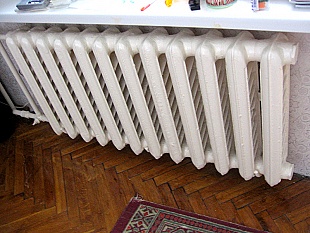
How to choose the right paint for the battery
The paint is designed to give a beautiful appearance and protect the surface from moisture, however, in this case, the substance must have a number of individual characteristics, such as:
- resistance to high temperatures;
- resistance to mechanical stress:
- will not collapse under the influence of aggressive liquids in the process of care;
- the paint must be odorless and not emit toxic substances.
For painting heating elements in residential premises, paints such as:
- acrylic;
- alkyd;
- water-dispersion enamels.
So, let's take a closer look:
- Acrylic paints have a beautiful glossy surface that retains its original appearance for quite a long time.
For your information: Acrylic dyes contain special organic components and during use they emit characteristic solvent odors that disappear after the mixture has completely dried.

- Alkyd substances are characterized by a high degree of resistance to high temperatures. They are popular because there are a huge number of different shades on sale that allow you to choose suitable color to any interior. However, these substances also have a characteristic odor when dried, and can also emit it under the influence of temperature.
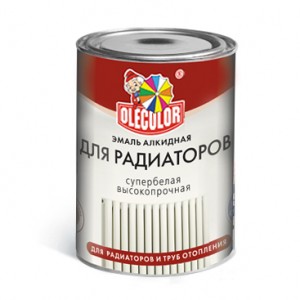
- Water-dispersion mixtures will be the best option for painting, since they are water-based, do not emit an unpleasant odor when working with them, and the drying speed is much faster than analogues. When choosing this type of paint, it is recommended to pay attention to the packaging. It has instructions for use, which should indicate that the mixture can be used for application to heating appliances.
Surface paint technology
In order to do it yourself, the heating must be turned off and the device itself must be cold. These recommendations will help to avoid uneven drying of the coating and the formation of streaks, which most often occurs when painting a hot battery.
You can also use special substances that are designed to be applied to a heated surface. Such substances include fire-retardant paints for polystyrene metal, however, the cost of such coatings is significantly higher than their conventional counterparts.
Tip: Surface treatment is usually done before the start of the heating season, if it is not possible to shut off the water supply to the battery on your own. In most cases, you can contact the ZhEK employees and ask them to temporarily turn off the hot water supply.
The staining process is as follows:
- on the initial stage protect the floor covering from accidental ingress of paint on its surface using a special film or plain paper;
- purchase a straight and curved brush in advance at a hardware store for painting hard-to-reach areas;
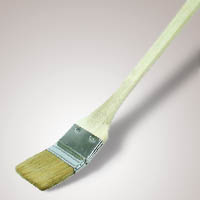
- if possible, clean the surface of the old coating using sandpaper or a special remover;
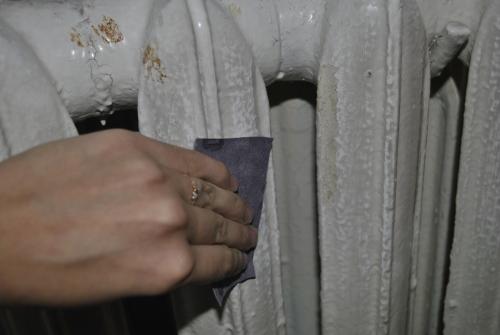
- when using toxic paints, take care of personal protection by preparing a respirator and ensuring ventilation of the room;
- Apply paint to the surface, starting from the top of the heater and gradually descending to the bottom. Try to paint hard-to-reach interior places first;
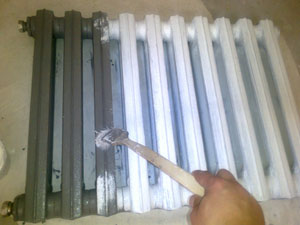
- Wait for the first layer to dry completely before applying the second one.
Please note: It is important to remember that colored paint is best applied in several layers. Try to apply two thin layers to the surface rather than one thick one, this will avoid streaks and uneven drying.
If the room is undergoing a complete renovation and there is no danger of damaging the surrounding objects with paint, it is recommended to use a paint sprayer. This will allow you to quickly and efficiently do the work with your own hands.
You can also purchase paints and varnishes in special cans, such mixtures dry quickly and are well applied to the surface, but their cost is slightly higher than conventional liquid counterparts.
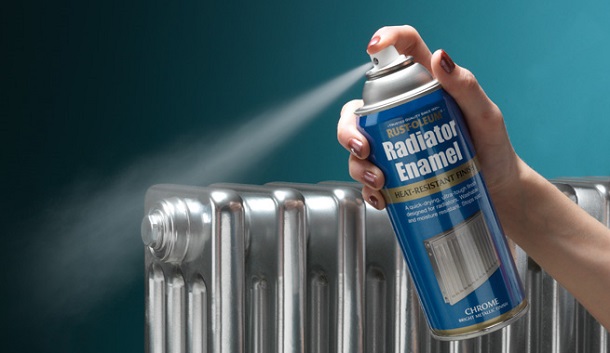
For painting electric oil or alcohol radiators, zinga conductive paint is often used, which simultaneously protects the surface of the device from the effects of temperatures, provides mechanical resistance and creates an additional layer of insulation that protects against inadvertent electric shock in case of damage to the radiator elements.
Conclusion
In any case, before using protective mixtures, it is important to carefully read the instructions for use, which describe the scope of the substance and the technology of its application to the treated surface. You can also watch the video in this article. Compliance with technology guarantees a quality result.
Immediately after installation or during operation, the main components of the heating system (batteries and pipes) require additional processing - painting. Given the specific conditions under which the devices operate (high coolant temperature), this process is not as simple as it might seem at first glance. For this reason, special paints for radiators are used.
They mean a suspension of mineral or organic colored substances (pigments) and binders - latex, drying oil, PVA emulsion. For painting radiators and indoor heating pipes, special compositions are used that are distinguished by increased heat resistance, non-toxicity, and durability. In addition, they must protect the metal from corrosion, be easy to clean from dust and dirt, while maintaining color.
What are the types
Depending on which components are taken as the basis, heat-resistant paint for batteries is produced in 3 types:
- Acrylic enamel.
It consists of resins, pigments and organic components, as well as specialized modifiers that increase anti-corrosion properties, thermal stability (up to +100 ºС) and so on. This paint is used to coat cast iron, steel and aluminum batteries. It dries quickly, gives the surface a glossy shine, is resistant to abrasion, and is durable. Since acrylic enamels contain an organic solvent, the disadvantage of this type of coloring matter is a sharp unpleasant odor, but it disappears over time.
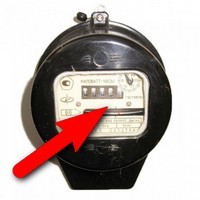

- Alkyd enamel.
Produced on the basis of pentaphthalic varnish and solvent (white spirit), with the addition of coloring pigments and fillers in the form of silicon oxide or marble chips. Suitable for painting radiators made of any metal. Resistant to abrasion, easy to clean, dries quickly.
Manufactured in a wide color scheme. The disadvantages include a rather high price. For example, paint for heating systems Dufa Heizkorperlack in a 2.5 kg package costs from 1500 to 1680 rubles. Also, alkyd enamels fade over time, can become covered with small cracks, and during the first 3-5 days after application, they emit a sharp, unpleasant odor.
- Water based.
A water-based radiator paint may contain acrylate, latex or polyvinyl acetate dispersion as a binder. It is used for coloring any types of heating devices and pipes.
The advantages of this type of coating are: the absence of a sharp, unpleasant odor, thermal stability, uniformity and strength of the coloring layer, durability. Perhaps the only drawback is the very high cost. The price of paint for Tikkurila Thermal heating pipes is from 2900 to 3300 rubles per 2.5 kg can.

In addition to the listed types of coloring compositions, oil-based suspensions are used, but much less frequently. They are suitable for radiators made of cast iron and steel as well as non-ferrous metals. Virtually odorless, resistant to high temperatures (up to +90 ° C), quick-drying, they are, however, not as durable as acrylic or alkyd compounds, although they are not inferior to them in price. For example, color paint for Alpina Heizkorper cast iron radiators costs between 1300–1450 rubles per 2.5 kg.
Brands of paints, their parameters
| paint type | Manufacturer / brand | Description | Main characteristics | Price, rub / 2.5 kg | ||
| Density, g/cm3 | Consumption, g/m2 | Complete drying time, hours | ||||
| Acrylic | VGT/VDAK 1179 | Glossy white enamel. Waterproof, abrasion resistant. Washes well, does not turn yellow over time. |
1,15–1,25 | 100 | 24 | 600–670 |
| Rogneda/Dali | Composition that forms a matte durable coating that can withstand heating up to +160 °C. | 1,20–1,30 | 90–100 | 24 | 580–650 | |
| Alkyd | Dufa Heizkorperlack | Quick-drying, heat-resistant enamel for coating radiators and pipes. | 1,15 | 140 | 12 | 1500–1680 |
| Tex | White heat-resistant semi-gloss enamel for cast iron and steel radiators, up to 100 °C. | 1,20 | 100–120 | 24 | 1100–1250 | |
| Water based | Tikkurila Thermal | Water-dispersion composition based on a latex binder with increased thermal stability (up to +230 ºС). Easy to apply with brush or spray. |
1,10 | 160–180 | 24 | 2900–3300 |
| Oily | Alpina Heizkorper | Based on oil resin, odorless, with increased resistance to abrasion. Easily tinted to any shade with colored pigments. |
1,20 | 90–120 | 10 | 1300–1450 |

How to choose the right
Having gone to the store for enamel for radiators, you should take into account some of the nuances that will help you avoid the most common mistakes and buy exactly the composition that suits your conditions:
- Read the specifications on the packaging carefully. Remember that special paints must withstand heating temperatures of +90 °C and above.
- If you plan to use it in a residential area, then an odorless water-dispersion paint that does not contain organic solvents would be an ideal option for a battery.
The primer must be compatible with the selected type of enamel. Otherwise, the coating will crack and quickly collapse, and the heater will suffer from corrosion.
DIY painting
There is nothing complicated in this process, and any owner can independently do all the work without involving specialists. paint iron pipes heating is easier at the end of the heating season, when they are cold. If it is necessary to do this in the dead of winter, it is recommended to turn off the coolant supply or use special enamels suitable for application to hot surfaces.
Radiators are painted in the following sequence:
1. Preparation. The old coating is removed with a spatula or a special liquid. It is recommended to carry out these works in a gauze bandage or a respirator. The surface of batteries or pipes is cleaned with sandpaper and degreased with a solvent, slightly alkaline solution or white spirit.
2. For anti-corrosion protection and better adhesion, a primer layer is applied.
3. To evenly apply the enamel, you will need brushes with soft bristles: straight and curved for processing hard-to-reach places.
4. Painting starts from top to bottom. At the first stage, the internal parts are covered, then the external ones.
5. According to reviews, it is better to paint the heating battery in 2 layers: after the first has dried (after 3–5 hours), the second is applied.
6. If the substance is sprayed from a can, then it should be kept at a distance of at least 30 cm from the surface. At the same time, there should be no open sources of fire in the room.




















